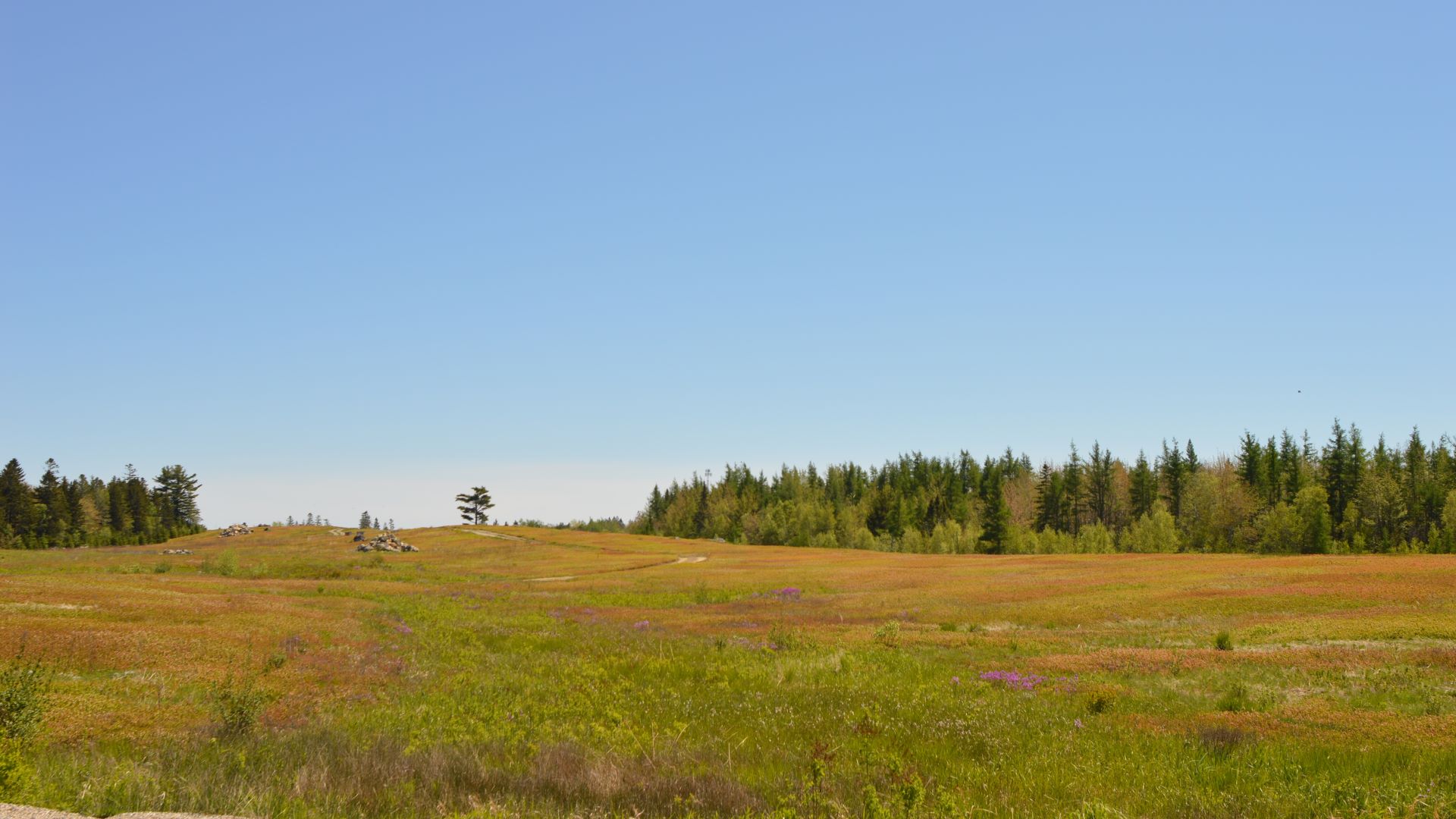On December 29, the proposal to create the Downeast Maine National Heritage Area (NHA) was signed into law by President Biden, making it the 56th in the country and the first in Maine. The designation recognizes the national contributions of Downeast Maine’s natural resources industries, including wild blueberries, fishing and forestry.
“This is a good thing for Downeast Maine,” says Marie Emerson. “We already have the conservation piece here in Washington County with 26% of our land here now in conservation — that is a huge amount. Now if we can build a really good tourism industry to preserve some of this and help the small farmers, the small fisherman and create small businesses, this will be very good for the area.”
For Emerson and her husband Dell, both longtime stewards of the wild blueberry in Washington County, the journey to both save and recognize the local wild blueberry farmers has morphed into a collective, regional passion to preserve the landscapes, industries and culture that define Downeast Maine that is now recognized by the federal government.
At the helm in the designation process has been Sunrise County Economic Council’s (SCEC) Crystal Hitchings. For the past couple of years, Hitchings has spearheaded a multi-faceted approach that moved its way through Washington and Hancock counties, culminating with the NHA designation.
“After years of hard work by many residents of Downeast Maine, including the wild blueberry growers who initiated the process, we now continue the work and continue to want the public’s input and encourage people to participate any way they can,” says Hitchings.
Senator Angus King and Rep. Jared Golden, both direct sponsors of the legislation along with co-sponsors Senator Susan Collins and Rep. Chellie Pingree, say, “There is nowhere more deserving of a heritage area designation. Making Hancock and Washington counties a National Heritage Area will open the door for critical federal funding and drive important economic activity and investments to support Downeast communities and the hardworking, resilient people who call these counties home.”
Humble beginnings
Back in the summer of 2021, Emerson, working with consultant Katherine Cassidy, transitioned the iconic domed building on Route 1 — Wild Blueberry Land — into a heritage center. Focused on telling both the story of the wild blueberry and the plight of small local farmers, Emerson started a journey that ultimately became a piece of the NHA designation for Maine.
The importance of this designation is not lost on Emerson. The wild blueberry is one of four indigenous fruits in North America, cared for by local tribes for millennia. “These lands, this rhizome system is to Maine as the rain forest is to the world, supporting a natural ecosystem,” says Emerson. “This industry finds itself in the same situation today as the sardine industry was in the 1950s and ’60s, and as Maine’s poultry industry was in the 1960s and ’70s.”
Emerson believes that the boost provided by NHA funding will help many current and new small businesses because of the financial support and that the designation makes the entire Downeast region a true destination.
Hitchings says that though the wild blueberry industry is not the sole focus, it will be buoyed with its essential inclusion in the story. “We do have a museum, an event and a few land trust preserves that have blueberries, but an NHA needs a lot of existing assets and they need to be national assets — like historic districts, parks, nationally recognized land features, nationally registered buildings, and so on,” says Hitchings. “Now wrapped within a much bigger story, the wild blueberry industry here in Maine can be highlighted.”
What is an NHA designation?
“An NHA is a method to preserve the story of America’s heritage through local, community-led efforts that capture a wide diversity of the nation’s shared experiences and strengthen local economic and community development initiatives,” says Hitchings.
The four core values for every NHA are: sustainable economic development, healthy environment and people, education and stewardship and community engagement and pride.
“NHA projects can help communities plan for and manage tourism in a manner that benefits communities and provides a meaningful and memorable visitor experience and potentially translates into new or retained residents and businesses,” Hitchings notes.
Before passage of the Downeast Maine NHA, there were 55 NHA designations throughout the U.S. Hitchings says anyone looking to see examples of the sorts of projects other NHAs have been doing should go here.
Asked if there is an example of an already existing NHA that Mainers could look to for potential project ideas, Hitchings cites a November 2022 BBC article — “A cutting-edge tourism model in Newfoundland” by Diane Selkirk — about a government-backed initiative in Newfoundland. “Although the community is not an NHA, it has utilized a similar approach and was very successful,” says Hitchings.
Traveling a peninsula in Newfoundland, the BBC writer moved from town to town finding stories embedded within the people amidst their livelihoods. And when combined with assistance from the government, the people were able to tell a more complete story that is the heritage of the Newfoundland community to a tourism industry that is now thriving. From the boatbuilding trade and teaching younger generations the skills to continue it, to artist’s studio tours, living history museums, historical sites, bed and breakfasts and one-of-a-kind restaurants — all amidst a natural beauty locals believe is sometimes surreal — this Canadian community is a success story and potential case study that Downeast Maine could emulate, Hitchings believes.
Planning and implementation
Once federal funds begin to flow the next step will be to create the management plan — a blueprint for how the NHA designation will be managed. “There’s no specific timeline for the release of the appropriations, but with the passage and signing of the bill, we’ll know more in the coming weeks,” says Edie Smith, regional representative for Senator King. The amount of money earmarked for the management plan process will be $150,000 annually for up to three years and will come from the Department of the Interior.
“The feasibility study brushed the surface of what the possibilities are; the management process is that deep dive into areas of communities and how we actually want to implement this,” says Hitchings. “Safe to say, this process will require even more significant public outreach.”
The management plan will outline the heritage-related goals and priorities of the entire region and will be led by SCEC staff, a core planning team and a newly assigned NHA program coordinator. Those involved in formulating the management plan will attend select board and city council meetings across the region and board and committee meetings of partner organizations. A series of public discussions and workshops in communities are planned, as are meetings with smaller groups of community leaders.
Hitchings says that the management plan will develop from all the information, input and ideas that come from these discussions. Drafts and revisions of the management plan will be shared and discussed, with a final draft submitted to the National Heritage Areas Program for final approval by the end of 2025.
Once the management plan is completed, project implementation will begin, allowing access to public federal funds. “Communities, organizations and schools are eligible to receive matching federal dollars for heritage-related projects,” says Hitchings. “NHAs are eligible for a maximum of $1 million per year over the course of 10 years, but the final amount provided is dependent on the amount of project funds raised locally.”
The range of topics/industries represented in the Downeast NHA story include: commercial fisheries, wild blueberries, farming, forest products, hunting/fishing/birding/guiding, local history, arts/culture/skilled crafts, education, outdoor recreation, conservation, municipal government, regional and tourism planning, economic development and health/wellness. Representatives from each of these areas and industries will become a part of the NHA management team. “This team will have a limited number of seats, as it will not be effective with too many people — or too few,” says Hitchings. “I am thinking 15 as a limit, meaning some of the team may need to have subject expertise in more than one topic.”
A grant review committee will also be formed. Committee members may include some from the management team but will also include people who have experience in grant review and oversight. “Each year there are likely to be a few different people on the grant review committee to eliminate any conflict of interest,” says Hitchings. “An organization, municipality or school that is represented on the management group is also eligible to apply for grants, but they cannot participate in the review process at all.”
As to how these groups will be chosen, Hitchings says, “The NHA coordinator will invite people to participate on these teams based on the coordinator’s knowledge of what is needed and who are the people across the region who can expertly and consistently participate. Anyone interested can nominate themselves or another person.”
“Maine’s delegation will want to stay connected and up to date on the NHA program for the duration of its implementation and will come to the region to experience the work being put into place,” says Smith. “There will not be direct involvement — this is a project that will be directed, managed and implemented by the people of Washington and Hancock counties.”
All information about meetings and draft sections of the developing plan will be posted and updated continuously on the SCEC website. Future meetings will be announced on SCEC’s weekly newsletter “Local Happenings” and on their Facebook page.
“This is a long-term program that is a continually unfolding and evolving process,” says Hitchings. “There will be no immediate or obvious effects. Everything that happens going forward will be up to the people of the communities. The focus of the NHA program is on community, not on tourists. Visitors will come because the communities are vibrant and healthy places.”
Sign up here to receive our free, periodic newsletter, Downeast Monitor, that focuses on Washington County news, a new offering at The Maine Monitor as part of our newsroom’s stepped-up efforts to cover Washington County. This article first appeared in the Quoddy Tides and was republished with permission.







